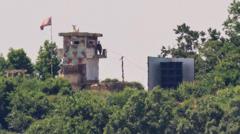North Korea officially stated that it has "never removed" its propaganda loudspeakers along the border with South Korea, contradicting claims made by Seoul earlier this week. Kim Yo Jong, sister of North Korean leader Kim Jong Un, declared the assertion as “unfounded” and reiterated that the North has no intentions of improving relations with its southern neighbor. In her remarks, published through state media KCNA, she suggested that this stance would be codified in North Korea's constitution.
This dispute emerges shortly after South Korea's military alleged that some of North Korea's loudspeakers had been dismantled, coinciding with Seoul's own cessation of its broadcasts aimed at the North. South Korea’s propaganda typically includes popular K-pop songs, while North Korea’s broadcasts are characterized by disconcerting sounds, such as howling animals, contributing to disturbance for residents living near the border.
Seoul's border residents have voiced concerns over the disruptive noise from both sides, sometimes occurring during late-night hours. North Korea has historically viewed these broadcasts from South Korea as provocative, even labeling them as acts of war—a position emphasized further by Pyongyang's past threats to destroy the speakers.
The dynamics of inter-Korean relations have fluctuated over time. Broadcasts from South Korea were resumed in June 2024 under former President Yoon Suk Yeol, who advocated a hardline approach to the North. This decision followed confrontations from Pyongyang involving balloon launches filled with refuse in response to escalating tensions.
More recently, under new President Lee Jae Myung, who campaigned on promises to enhance inter-Korean relations, South Korea halted its broadcasts as a gesture to build trust and promote peace. Despite these attempts, relations between the two Koreas continue to be strained. North Korea has recently threatened "resolute counteraction" in light of scheduled military exercises between South Korea and the United States, further indicating the volatility in the region.



















